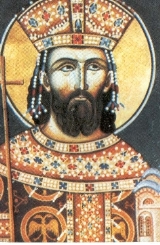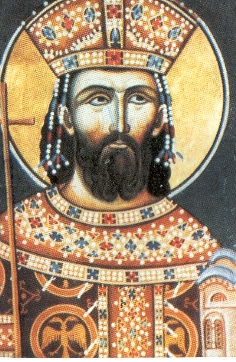
Moravian Serbia
Encyclopedia
The Moravian Serbia was one of the states that emerged from the collapse of the Serbian Empire
in the 14th century. The state was created through political and military activities of its first ruler Prince Lazar Hrebeljanović, who later fought and perished at the Battle of Kosovo
.
 Lazar Hrebeljanović left Prizren in the early 1370s, and devoted himself to the consolidation of his power in the northern Serbian regions around his court in Kruševac
Lazar Hrebeljanović left Prizren in the early 1370s, and devoted himself to the consolidation of his power in the northern Serbian regions around his court in Kruševac
. Although a pledged vassal to Stefan Uroš, in 1371 he refused to participate in the Battle of Maritsa
, at which the bulk of the imperial Serbia
n army was destroyed by an Ottoman
force. Soon afterwards, Stefan Uroš died. He had been the last of the Nemanjić emperors. Through a combination of diplomacy, military action, and family alliances, Lazar emerged from the resulting power vacuum as the most powerful Serbian noble not in the Ottomans
' service. He acquired dynastic legitimacy by marrying Milica Nemanjić, and despite retaining only the minor title of knez ("prince"), he nevertheless used the imperial name of 'Stefan' as well as the designation "autocrator".
Lazar spent his time strengthening the Serbian state, knowing fully well that he would eventually have to face the Ottoman threat. He unified most of Serbia under his rule and managed to gain the loyalty of a majority of the Serbs. He also ceded the title "King of Serbs" to King Tvrtko of Bosnia (who in any case had more ties to the Nemanjic's than Prince Lazar). His first major military action was at the Battle of Dubravnica
where his two subjects, Crep and Vladimir managed to decisively defeat an Ottoman army in southern Serbia. No further recorded hostilities took place until the Battle of Pločnik
where Knez Lazar managed to crush an Ottoman force and drive them back to Niš
. Serbian troops also took part in the Battle of Bileća
where again he defeated the Turks.
Lazar was killed during the 1389 Battle of Kosovo
along with most of Serbia's political elite. After Lazar's death, his son Stefan Lazarević
succeeded him and became the prince of Moravian Serbia in 1389. Immediately after the Battle of Kosovo
, King Sigismund of Hungary attacked and ravaged Moravian Serbia from the north. Unable to fight on two fronts, the young Prince Stefan thwarted the Hungarians and agreed to Ottoman vassalage and participated as an Ottoman vassal in the Battle of Karanovasa
in 1394, the Battle of Rovine
in 1395, the Battle of Nicopolis
in 1396, and in the Battle of Angora
in 1402. After Angora, he was given the title of Despot of Serbia in 1402 and in 1403 he proclaimed Belgrade
the capital of his new state, that became known as the Serbian Despotate
.
Serbian Empire
The Serbian Empire was a short-lived medieval empire in the Balkans that emerged from the Serbian Kingdom. Stephen Uroš IV Dušan was crowned Emperor of Serbs and Greeks on 16 April, 1346, a title signifying a successorship to the Eastern Roman Empire...
in the 14th century. The state was created through political and military activities of its first ruler Prince Lazar Hrebeljanović, who later fought and perished at the Battle of Kosovo
Battle of Kosovo
The Battle of Kosovo took place on St. Vitus' Day, June 15, 1389, between the army led by Serbian Prince Lazar Hrebeljanović, and the invading army of the Ottoman Empire under the leadership of Sultan Murad I...
.
History

Kruševac
Kruševac is a city and municipality, and the administrative center of the Rasina District, in central Serbia. According to the 2011 census, the municipality has a population of 127,429, while the town has 57,627....
. Although a pledged vassal to Stefan Uroš, in 1371 he refused to participate in the Battle of Maritsa
Battle of Maritsa
The Battle of Maritsa, or Battle of Chernomen, took place at the Maritsa River near the village of Chernomen on September 26, 1371 between the forces of the Ottoman sultan Murad I's lieutenant Lala Şâhin Paşa and the...
, at which the bulk of the imperial Serbia
Serbia
Serbia , officially the Republic of Serbia , is a landlocked country located at the crossroads of Central and Southeast Europe, covering the southern part of the Carpathian basin and the central part of the Balkans...
n army was destroyed by an Ottoman
Ottoman Empire
The Ottoman EmpireIt was usually referred to as the "Ottoman Empire", the "Turkish Empire", the "Ottoman Caliphate" or more commonly "Turkey" by its contemporaries...
force. Soon afterwards, Stefan Uroš died. He had been the last of the Nemanjić emperors. Through a combination of diplomacy, military action, and family alliances, Lazar emerged from the resulting power vacuum as the most powerful Serbian noble not in the Ottomans
Ottoman Empire
The Ottoman EmpireIt was usually referred to as the "Ottoman Empire", the "Turkish Empire", the "Ottoman Caliphate" or more commonly "Turkey" by its contemporaries...
' service. He acquired dynastic legitimacy by marrying Milica Nemanjić, and despite retaining only the minor title of knez ("prince"), he nevertheless used the imperial name of 'Stefan' as well as the designation "autocrator".
Lazar spent his time strengthening the Serbian state, knowing fully well that he would eventually have to face the Ottoman threat. He unified most of Serbia under his rule and managed to gain the loyalty of a majority of the Serbs. He also ceded the title "King of Serbs" to King Tvrtko of Bosnia (who in any case had more ties to the Nemanjic's than Prince Lazar). His first major military action was at the Battle of Dubravnica
Battle of Dubravnica
The Battle of Dubravnica was fought in the summer of 1380 or December 1381, on the Dubravnica River near Paraćin in today's central Serbia, between the Serbian forces of Prince Lazar of Serbia led by commanders Vitomir and Crep and the invading Ottoman Turks of Sultan Murad I...
where his two subjects, Crep and Vladimir managed to decisively defeat an Ottoman army in southern Serbia. No further recorded hostilities took place until the Battle of Pločnik
Battle of Plocnik
The Battle of Pločnik was fought in 1386 , at the village of Pločnik, near Prokuplje in today's southeastern Serbia, between the Serbian forces of prince Lazar Hrebeljanović and the invading Ottoman Turks of sultan Murad I.It was the second clash between the Ottomans and forces commanded by Lazar,...
where Knez Lazar managed to crush an Ottoman force and drive them back to Niš
Niš
Niš is the largest city of southern Serbia and third-largest city in Serbia . According to the data from 2011, the city of Niš has a population of 177,972 inhabitants, while the city municipality has a population of 257,867. The city covers an area of about 597 km2, including the urban area,...
. Serbian troops also took part in the Battle of Bileća
Battle of Bileca
The Battle of Bileća was fought on 27 August 1388 between Bosnian forces led by Duke Vlatko Vuković and the Ottomans under the leadership of Lala Shahin Pasha...
where again he defeated the Turks.
Lazar was killed during the 1389 Battle of Kosovo
Battle of Kosovo
The Battle of Kosovo took place on St. Vitus' Day, June 15, 1389, between the army led by Serbian Prince Lazar Hrebeljanović, and the invading army of the Ottoman Empire under the leadership of Sultan Murad I...
along with most of Serbia's political elite. After Lazar's death, his son Stefan Lazarević
Stefan Lazarevic
Stefan Lazarević known also as Stevan the Tall was a Serbian Despot, ruler of the Serbian Despotate between 1389 and 1427. He was the son and heir to Prince Lazar, who died at the Battle of Kosovo against the Turks in 1389, and Princess Milica from the subordinate branch of the Nemanjić dynasty...
succeeded him and became the prince of Moravian Serbia in 1389. Immediately after the Battle of Kosovo
Battle of Kosovo
The Battle of Kosovo took place on St. Vitus' Day, June 15, 1389, between the army led by Serbian Prince Lazar Hrebeljanović, and the invading army of the Ottoman Empire under the leadership of Sultan Murad I...
, King Sigismund of Hungary attacked and ravaged Moravian Serbia from the north. Unable to fight on two fronts, the young Prince Stefan thwarted the Hungarians and agreed to Ottoman vassalage and participated as an Ottoman vassal in the Battle of Karanovasa
Battle of Karanovasa
The Battle of Karanovasa took place on 10 October 1394 between the Wallachian army led by Voivode Mircea cel Bătrân against an Ottoman invasion led by sultan Bayezid I. This battle is sometimes confused with the later Battle of Rovine The Battle of Karanovasa (lit. "Battle of the Trenches") took...
in 1394, the Battle of Rovine
Battle of Rovine
The Battle of Rovine took place on 17 May 1395 between the Wallachian army led by Voivod Mircea cel Bătrân against the Ottoman invasion led by sultan Bayezid I. The Ottoman army, numbering approximately 40,000 men, faced the much smaller Wallachian army, which was about 10,000 men...
in 1395, the Battle of Nicopolis
Battle of Nicopolis
The Battle of Nicopolis took place on 25 September 1396 and resulted in the rout of an allied army of Hungarian, Wallachian, French, Burgundian, German and assorted troops at the hands of an Ottoman force, raising of the siege of the Danubian fortress of Nicopolis and leading to the end of the...
in 1396, and in the Battle of Angora
Battle of Ankara
The Battle of Ankara or Battle of Angora, fought on July 20, 1402, took place at the field of Çubuk between the forces of the Ottoman sultan Bayezid I and the Turko-Mongol forces of Timur, ruler of the Timurid Empire. The battle was a major victory for Timur, and it led to a period of crisis for...
in 1402. After Angora, he was given the title of Despot of Serbia in 1402 and in 1403 he proclaimed Belgrade
Belgrade
Belgrade is the capital and largest city of Serbia. It is located at the confluence of the Sava and Danube rivers, where the Pannonian Plain meets the Balkans. According to official results of Census 2011, the city has a population of 1,639,121. It is one of the 15 largest cities in Europe...
the capital of his new state, that became known as the Serbian Despotate
Serbian Despotate
The Serbian Despotate was a Serbian state, the last to be conquered by the Ottoman Empire. Although the Battle of Kosovo in 1389 is generally considered the end of the medieval Serbian state, the Despotate, a successor of the Serbian Empire and Moravian Serbia survived for 70 more years,...
.
Rulers
- Lazar Hrebeljanović (1371–1389)
- Stefan LazarevićStefan LazarevicStefan Lazarević known also as Stevan the Tall was a Serbian Despot, ruler of the Serbian Despotate between 1389 and 1427. He was the son and heir to Prince Lazar, who died at the Battle of Kosovo against the Turks in 1389, and Princess Milica from the subordinate branch of the Nemanjić dynasty...
(1389–1402)

